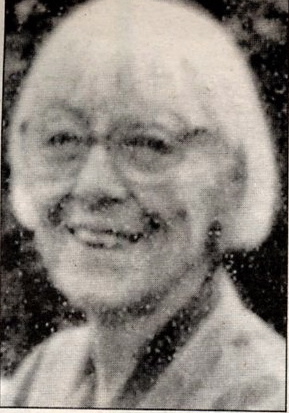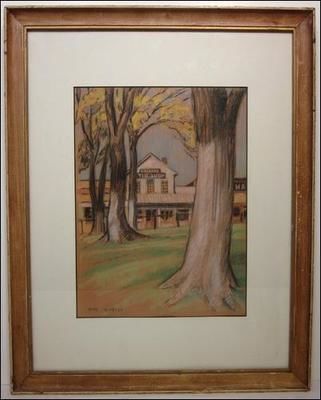Encyclopedia Dubuque
"Encyclopedia Dubuque is the online authority for all things Dubuque, written by the people who know the city best.”
Marshall Cohen—researcher and producer, CNN
Affiliated with the Local History Network of the State Historical Society of Iowa, and the Iowa Museum Association.
HALLIBURTON, Louise Herron: Difference between revisions
No edit summary |
No edit summary |
||
| Line 9: | Line 9: | ||
objectors. (1) | objectors. (1) | ||
She was considered neither shrill or humorless about the causes she represented. A friend noted,"she has perfected the art of being at one with people who hold widely divergent opinions from her own. Her protest of the Vietnam War began in 1966 after the Quaker group whose meetings she had attended moved away. Halliburton and Mimi Vernon moved to [[WASHINGTON PARK]] and began a silent vigil that continued every Sunday morning for seven years until the war ended. (2) In 1970 when the New York Times came to Dubuque, Halliburton broke ranks with the other protestors and walked a block away from Washington Park to be interviewed. "We normally don't break the vigil but I said I would for The New York Times." ( | She was considered neither shrill or humorless about the causes she represented. A friend noted,"she has perfected the art of being at one with people who hold widely divergent opinions from her own. Her protest of the Vietnam War began in 1966 after the Quaker group whose meetings she had attended moved away. Halliburton and Mimi Vernon moved to [[WASHINGTON PARK]] and began a silent vigil that continued every Sunday morning for seven years until the war ended. (2) Joined later by others, the demonstrators wore small white signs reading "Silent Vigil for Peace" and stood without speaking or moving from 10:00-11:00 a.m. each Sunday. (3)In 1970 when the New York Times came to Dubuque, Halliburton broke ranks with the other protestors and walked a block away from Washington Park to be interviewed. "We normally don't break the vigil but I said I would for The New York Times." (4) | ||
Halliburton's life as an agent for social change began early. She successfully petitioned the school superintendent to allow her to take a manual training class only open for boys at that time. Halliburton studied at the Corcoran Gallery in Washington, D.C. where she received honorable mention in water color. When a mechanical drafting position in the water transport service opened, she applied and began designing river steamers' hulls. While living in New York City she involved herself in rug and textile design creating original designs for custom made rugs. She also worked with an Indian rug business copying designs from Indian rugs displayed in the Metropolitan Museum. Halliburton studied art while living in Indiana and later at the Norton School of Art in West Palm Beach, Florida. By 1951 her work was displayed at Franklin College, Franklin, Indiana; Strait Museum, Lake Worth, Florida; and by the [[DUBUQUE ART ASSOCIATION]]. ( | Halliburton's life as an agent for social change began early. She successfully petitioned the school superintendent to allow her to take a manual training class only open for boys at that time. Halliburton studied at the Corcoran Gallery in Washington, D.C. where she received honorable mention in water color. When a mechanical drafting position in the water transport service opened, she applied and began designing river steamers' hulls. While living in New York City she involved herself in rug and textile design creating original designs for custom made rugs. She also worked with an Indian rug business copying designs from Indian rugs displayed in the Metropolitan Museum. Halliburton studied art while living in Indiana and later at the Norton School of Art in West Palm Beach, Florida and the Pennsylvania Academy of Art in Chester Springs, Pennsylvania. (5) By 1951 her work was displayed at Franklin College, Franklin, Indiana; Strait Museum, Lake Worth, Florida; and by the [[DUBUQUE ART ASSOCIATION]]. (6) | ||
In later years, she joined the War Resisters' League and was the only protester to march with conscientious objectors during [[WORLD WAR II]]. She was associated with the National Association for the Advancement of Colored People (N.A.A.C.P.), American Friends Service Committee, and the Dubuque Quaker meetings. In 1986 she received the annual peace prize fro the Women's Action for Nuclear Disarmament at its Mother's Day for Peace event. ( | In later years, she joined the War Resisters' League and was the only protester to march with conscientious objectors during [[WORLD WAR II]]. She was associated with the National Association for the Advancement of Colored People (N.A.A.C.P.), American Friends Service Committee, and the Dubuque Quaker meetings. In 1986 she received the annual peace prize fro the Women's Action for Nuclear Disarmament at its Mother's Day for Peace event. (7) | ||
[[File:halliburton1936.jpg|200px|thumb|left|Halliburton picture-1936]]A past officer of the [[DUBUQUE ART ASSOCIATION]], she had works exhibited at the [[UNIVERSITY OF DUBUQUE]], [[CLARKE COLLEGE]], and the [[CARNEGIE-STOUT PUBLIC LIBRARY]]. Her paintings are held in private collections across the United States. | [[File:halliburton1936.jpg|200px|thumb|left|Halliburton picture-1936]]A past officer of the [[DUBUQUE ART ASSOCIATION]], she had works exhibited at the [[UNIVERSITY OF DUBUQUE]], [[CLARKE COLLEGE]], and the [[CARNEGIE-STOUT PUBLIC LIBRARY]]. Her paintings are held in private collections across the United States. | ||
| Line 25: | Line 25: | ||
2. Ibid. | 2. Ibid. | ||
3. | 3. "A Peace Vigil Every Sunday," ''Telegraph-Herald,'' February 12, 1968, p. 1 | ||
4. | 4. Shipley, Florence D., ''When the New York Times Comes to Dubuque''," March 15, 1970, p. 7 | ||
5. "Mother's Day Peace Event," ''Telegraph Herald'', May 8, 1986, p. 17 | 5. "Louise Halliburton to Exhibit Watercolors," ''Telegraph-Herald'', November 12, 1961, p. 13 | ||
6. "Dubuque Artist's Work Will Be Put on Display," ''Telegraph-Herald'', September 9, 1951, p. 17 | |||
7. "Mother's Day Peace Event," ''Telegraph Herald'', May 8, 1986, p. 17 | |||
[[Category: Artist]] | [[Category: Artist]] | ||
[[Category: Civil Rights]] | [[Category: Civil Rights]] | ||
Revision as of 22:42, 22 October 2018
HALLIBURTON, Louise Herron. (Dubuque, IA, 1897--Dubuque, IA, Aug. 7, 1991). Halliburton was described in a 1970 New York Times article about Dubuque as
a pacifist since she saw the first draft numbers
drawn out of a fish bowl in Washington before
WORLD WAR I. Mrs. Halliburton has fasted for
peace, picketed for civil rights and against the
VIETNAM WAR, leafleted at the Pentagon and
consistently befriended Iowa's conscientious
objectors. (1)
She was considered neither shrill or humorless about the causes she represented. A friend noted,"she has perfected the art of being at one with people who hold widely divergent opinions from her own. Her protest of the Vietnam War began in 1966 after the Quaker group whose meetings she had attended moved away. Halliburton and Mimi Vernon moved to WASHINGTON PARK and began a silent vigil that continued every Sunday morning for seven years until the war ended. (2) Joined later by others, the demonstrators wore small white signs reading "Silent Vigil for Peace" and stood without speaking or moving from 10:00-11:00 a.m. each Sunday. (3)In 1970 when the New York Times came to Dubuque, Halliburton broke ranks with the other protestors and walked a block away from Washington Park to be interviewed. "We normally don't break the vigil but I said I would for The New York Times." (4)
Halliburton's life as an agent for social change began early. She successfully petitioned the school superintendent to allow her to take a manual training class only open for boys at that time. Halliburton studied at the Corcoran Gallery in Washington, D.C. where she received honorable mention in water color. When a mechanical drafting position in the water transport service opened, she applied and began designing river steamers' hulls. While living in New York City she involved herself in rug and textile design creating original designs for custom made rugs. She also worked with an Indian rug business copying designs from Indian rugs displayed in the Metropolitan Museum. Halliburton studied art while living in Indiana and later at the Norton School of Art in West Palm Beach, Florida and the Pennsylvania Academy of Art in Chester Springs, Pennsylvania. (5) By 1951 her work was displayed at Franklin College, Franklin, Indiana; Strait Museum, Lake Worth, Florida; and by the DUBUQUE ART ASSOCIATION. (6)
In later years, she joined the War Resisters' League and was the only protester to march with conscientious objectors during WORLD WAR II. She was associated with the National Association for the Advancement of Colored People (N.A.A.C.P.), American Friends Service Committee, and the Dubuque Quaker meetings. In 1986 she received the annual peace prize fro the Women's Action for Nuclear Disarmament at its Mother's Day for Peace event. (7)
A past officer of the DUBUQUE ART ASSOCIATION, she had works exhibited at the UNIVERSITY OF DUBUQUE, CLARKE COLLEGE, and the CARNEGIE-STOUT PUBLIC LIBRARY. Her paintings are held in private collections across the United States.
---
Source:
1. McCormick, John, "Even Off Stage, Louise Halliburton Nudges People," Telegraph Herald, February 7, 1982, p. 5
2. Ibid.
3. "A Peace Vigil Every Sunday," Telegraph-Herald, February 12, 1968, p. 1
4. Shipley, Florence D., When the New York Times Comes to Dubuque," March 15, 1970, p. 7
5. "Louise Halliburton to Exhibit Watercolors," Telegraph-Herald, November 12, 1961, p. 13
6. "Dubuque Artist's Work Will Be Put on Display," Telegraph-Herald, September 9, 1951, p. 17
7. "Mother's Day Peace Event," Telegraph Herald, May 8, 1986, p. 17



